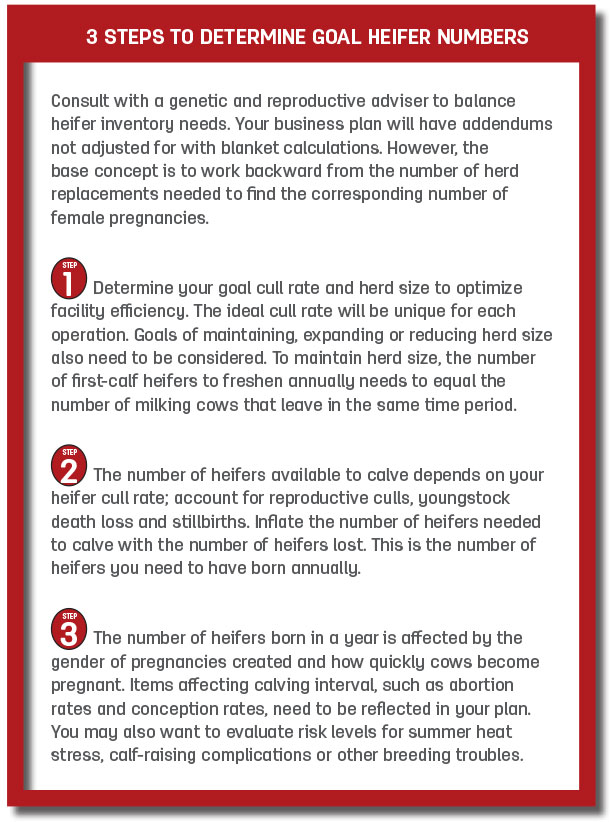Utilizing beef semen in dairies has become an increasingly popular strategy. However, it needs to be aligned with your customized business plan. One method does not work profitably for all.
The amount of beef semen used, which cows or heifers are bred to sexed semen and the number of dairy replacements needed are always herd- specific. Furthermore, the plan needs to be consistently monitored due to variable environmental factors, such as reproductive rates, culling levels and youngstock death loss.
Know your market
Before entering into any new product production, such as beef crossbred calves, evaluate the product’s marketability. Today, beef-on-dairy crossbred calves command a premium in most regions. We also know everything cycles.
Shifts in the beef market will affect the value of this growing crossbred population. As supply increases, calf buyers will become more selective. A calf with a black coat will not necessarily make it worthy of an enhanced price. Using “bargain-bin semen” could ultimately end up being expensive, in the short and long term, if calves do not have value or if the bulls themselves are not evaluated properly for use on dairy cattle.
A bull without fertility or calving performance data could actually cost your business money through cows not conceiving or causing calving problems. Longer term, crossbred calves need to be competitive in feedlot performance and carcass quality. Generic beef bulls are not good enough for the saturated marketplace you will be entering. Utilize beef genetics specifically designed to create optimized beef-on-dairy cross calves.
Do not set yourself up for failure in the marketplace nine months before you even have a product to offer.
High-performing breeds, resulting from high-performing bulls, will continue to carry appeal. Be cautious if approached to produce calves for a single buyer’s specialty program. Unless contracted, those narrow-appeal calves can be a liability if the buyer is no longer interested in the product. The feeder industry expects consistent performance, which may be achieved with genetics developed and proven to deliver.
Quality control on-farm, beyond using top genetics, is another aspect of ensuring buyers want your calves. Calf care and maternity pen protocols are just as important for these births as your future herd replacements. Also, take care sire identification is accurate. Too often, black dairy calves, especially from crossbred herds, can be misidentified as beef-cross calves. Make sure your brand is protected and reputation as a source for superior beef calves is known.
Analyze when it makes the most sense to sell your crossbred calves. For some producers, selling at day-old is the best option. Others with adequate facility and feed resources might choose to raise calves, if it can be done with an economical cost of gain. Another consideration is to retain ownership into feedyards for custom finishing. While this can be an opportunity to add even further value, there is continued responsibility for market and death loss risk with these models.
Not too little, not too much
When using sexed semen, dairies no longer need to question if they can produce an adequate supply of heifers. The new question is what number of heifers are needed to replace cows culled from the herd and maximize efficiency. Recall the children’s story Goldilocks and the search for balance; without shortage or excess, but just right. Now think of the Goldilocks principle as an economic phenomenon: Items must fall within certain margins to reach this fiscally “just right” equilibrium.
How much did your heifer program cost last year? What is the value to reduce this line item 10 to 20 percent? Fewer heifers means less resources for labor, facilities and feed. Just because you can make many heifers with sexed semen, doesn’t mean you should.
Gauging future heifer prices, it is optimistic to assume markets cycle, but we need to also remember technology continues to improve. The introduction of sexed semen technology, complemented by enhanced on-farm management improvements such as reproduction and calf care, has directly impacted the number of heifers available on the market.
Producers can make more heifers, more quickly, than ever before. Unless you have a realistic market to sell excess replacements into, which will recoup all raising expenses, a cost benefit exists for not making extra heifers. Do not be tempted to waste resources on heifers you do not need by following the three steps listed here (right) for determining heifer herd number goals.
Determine the career path for each herd member
Not every heifer or cow has the same role in your herd replacement program. Low-genetic cattle should not contribute their genetics to the next generation. While still producing milk and generating income during their productive life, breeding them to beef semen makes their genetics terminal. Their offspring are more valuable as beef crossbreds instead of unprofitable replacements.
It costs the same amount to raise a poor-genetic heifer up to freshening as it does a top-genetic heifer. However, the top-genetic heifer will pay you back more quickly. Segment your females for sexed semen breedings based on expected future profitability for your herd. You don’t like all the cows in your herd equally. Don’t make the next generation equally.
Perform a genetic audit to identify your herd’s predicted highest-return females based on genetic traits and trends. When people try to make decisions using industry genetic trends without looking at their specific data, they will either be lucky or wrong. Using a customized index ranking creates balanced progress with direct correlation to herd needs.
The inputs for a custom index ranking depend on available data. If pedigree information is accurate, parent average genetic traits may be good enough. Parent averages are best when used in grouping populations of females, such as finding the group of high and low genetics. It will not reliably determine which is the exact best or worst individual heifer.
Genomic testing increases reliability and is especially useful for herds with limited pedigree information. Genomic predicted transmitting abilities (PTAs) are especially worth the investment if the mistake you might make using only parent averages is worth, to your operation, the cost of testing.
After ranking females, the final step is to implement a logical and easily understood plan with your breeding technicians. An elaborate design on paper is meaningless if breeders cannot accurately execute the plan. Complicated breeding strategies can also affect other performance areas, such as lockup times. Often, a percentile ranking or genetic code designation is the most logical method.
Review your genetic goals with a genetic adviser to determine what makes the most sense for your operation. For many herds with surplus heifers causing bottlenecks in their operation and bringing unnecessary raising costs, the decision to breed dairy to beef can be an easy one. ![]()

-
Mandy Schmidt
- North American Dairy Genetic Services Specialist
- ABS Global
- Email Mandy Schmidt







